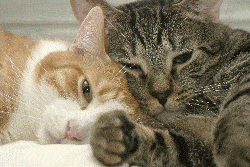Here is a question for the ages among cat lovers – “Should you declaw your cat?”. There are so many sides to this one that we are going to try and explore the main reasons for and against, giving you as much information that you need to make a responsible decision.
Scientifically Speaking
The medical name for declawing is called onychectomy. It is done by amputating the first knuckle on the front and/or hind legs. On strictly medical terms, declawing is only necessary due to destructive clawing of things like woodwork, furniture, screens, beds and blankets and the like. There is no scientific evidence that a declawed cat suffers behavioral changes compared with cats that still retain their claws, although increased biting and/or litter box training may be affected. This has not been proven to be a side-effect of declawing, since declawing is generally done when a cat is young and it is hard to chart a cats personalty as it grows older. However, there is evidence that many cats are abandoned and left for strays because of destructive scratching.
Since it is considered an amputation, make no mistake that your cat will feel pain for several days with possible slight bleeding afterwards, but it will subside over time and they will get on with their regular lives. Once declawed, a cat is virtually defenseless and should be housed and kept indoors for life.
Front to Back

In most cases only the front claws are used in this manner, and because of this, a common practice is to have the fronts declawed while allowing the rear paws to remain intact. This gives a bit of self defense if the cat ever manages to get out and finds itself confronted by another cat.
Alternatives
There are many alternatives to cat declawing, and they are all based on the premise of preventing a cat from scratching something valuable.
- Trimming — If you trim a cats nails regularly, you can keep them squared off and dull. A dull nail does far less damage than a sharp nail to anything being scratched, and it is a viable alternative.
- Scratching Posts — The most common deterrent for cat scratching is to make sure they have plenty of things to scratch besides furniture and woodwork. Scratching posts come in several shapes, sizes and textures, with some being scented to be even more appealing to kitty. If a cat favors a scratching post above anything else, and you may need one in each room, your scratching problems may be solved.
- Plastic Caps — These caps literally cover a cats real claws to reduce or eliminate scratch marks. They are glued on and must be replaced every 6 weeks or so, but they are a reliable deterrent, and can make the difference between ruined or non-ruined materials.
- Sticky Tape — Cats do not like to touch sticky things, and there are specially made tapes that can be attached to places where cats like to scratch. They will avoid it almost without fail, and will find something else to scratch, like a scratching post, instead of something more cherished.
There is virtually no humane society that recommends the declawing of cats, and in some places the practice has been banned as cruelty to animals. In the best interest of kitty, it would be far better to explore alternatives in an attempt to stop destructive scratching behavior, but as the cats owner, you’ll have to decide on a course of action that works best for you and your buddy.
ADDITIONAL RESOURCES: Is cat declawing inhumane?




